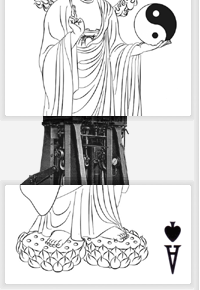標籤:
文化討論,
塘西散人
A Case Study on Ethnicity: the Construction of Kurdistan in Iraq
Introduction
From the very beginning of the establishment of modern Iraq, the Kurds reside in the north part of the state started their endless struggle of rebuilding their own Kurdistan and causing a series of ethnical conflicts within the country in the 20th century and still continuing now-a-day. This struggle is actually the result of the history problems of the region and also the political campaigns the western super powers play on the land of Middle East, of which affecting the progress of reconstructing the Kurdistan and as well as their ethnical identity. In this paper I will first review the formation of the Kurds’ ethnic identity in its specific historical and contemporary political context, then the focus will switch to the ethnical identity of the Kurds in Iraq after the First World War till the two Gulf Wars as an case study, with all this discussions according to different theories of including both the theories from the instrumentalist approach and constructivist approach. I will show that each approach of those theories is actually describing different aspect of the ethnic group’s situation and synthesis of the theories is somehow possible in the case of the Kurds, just as Sokolovskii & Tishkov foresee , “all the approaches to understanding ethnicity are not necessarily mutually exclusive” (1996: 192)
The formation of ethnic identity of the Kurds in their context
As refer to the ancient tales of the Kurds, they “claim to be the desecendants of the Medes, who helped overthrow the Assyrian Empire in 612 B.C., and they recite interesting myths about their origin involving King Solomon, jinni, and other magical agents. Many believe that the Kardouchoi, mentioned in the Anabasis by Xenophon as having given his 10000 such a mauling that they retreated from Persia in 401 B.C. were the ancestor of Kurds” (Gunter 2003: 153). Which this sharing origin is seen as an essential ethnic boundary maker as Nash suggests, “the presumed biological and unity of the group implying a stuff or substance continuity each group member has and outsiders do not.” (1989: 25)
Although they claim such glorious ancestors, they were suffered from serious invasions by the Arabian, the Mongolian, Christian and the Turkish due to its specific geographical location of which is the crossroad of the three continents: Asia, Europe and Africa. As Nezan suggests, “this country of high mountains, interspread with a multitude of valleys, is at the crossroads of the routes linking Asia to Europe and the Russian steppes facilitated a series of great invasion which across the centuries, destroyed the internal social and political process which would have led to the emergence of a united Kurdish political entity.” (1996: 12)
With these serious external invasions by the neighbors, though there’s once a united sovereign under the rule of Saladin, the Kurdistan kept in the mode of lordly domains and principalities after Saladin which bothering the development of a unique Kurdish civilization. They struggle between different strong neighbors, including the Turkish dynasties after the Mongolian, the Persian and later the Ottomans and the Safavids of Iran (Chaliand 1994:23), until “in 1515, the Kurdish princes signed a pact with the Ottoman Sultan Selim I which recognized Kurdish autonomy in exchange for a military alliance against the Shi’ite Persian Empire.” (Nezan 1996:12). Only in the following centuries, because of the Turko-Kurdish pact, the Kurds lived in a relatively stable and independent condition and hence “were able to develop their own civilization, a rich national culture expressed in their own language.” (ibid. :13). However, these Kurdish principalities and lordly domains were required “not to modify the frontiers of their ‘state’, supposedly so as to protect the rights of adjoining principalities but actually to prevent the emergence of a centralized state in Kurdistan.”(Kendal 1980: 22) This very much limited the development of the Kurdish political institution.
With the declining of the Ottoman Turkey Empire in nineteenth century, the Kurdistan exhausted by the recruitment of the Ottoman Sultan’s Sublime Porte for the wars in Europe and also the frequent warfare of the two Russo-Turkish and Turko-Persian wars, which led to a general discontent towards the Ottoman authorities as Kendal pointed out (ibid., 25 ). He also suggest that this discontent together with the in-flow of the European nationalism “finally began to have an impact on the Kurdish feudal chieftains, whose privileges were being threatened. The defence of these privileges, the stubborn refusal to pay any tribute whatsoever or to furnish the Porte with soldiers was to be the driving force of over fifty insurrections which broke out during the century” and one of the major common features of this insurrections is “geared to the creation of an independent Kurdistan” (ibid.). This show that the aware of early ethnic identity of the Kurds can be explained best with the Cohen’s ethnicity theory of power relations (1974: xiv-xv) as the conflicts between the Kurds and the Ottoman authority were actually the result of the breaking up of political and economic relation between the two sides. The Kurdish chieftains made use of this early sense of ethnic identity to defence their economic and politic privileges, though, one may still argue that these movements of independent are actually the Kurdish people’s rational choice ( Hechter 1986: 90-98) between the suppression of the Ottoman authority and the propaganda of their leaders.
However, despite of the strong sense of sharing origin myth and history, the development of a “rich nation culture” in sixteenth century, and also this fifty uprisings within nineteenth century for a independent Kurdistan of which some could only be crushed with the help of European Countries, the Kurds still could not form an overwhelming sense of nationalism or ethnic identity until very recent in the history. Some scholars account this situation for the Kurds’ specific tribal social organization (Chaliand 1994: 19-23, Eller 1999: 149-151, Kendal 1980: 23-24), the religious diversity (Chaliand 1994: 16-19, Eller 1999: 146-149, Kendal 1980: 23) and also the language diversity. (Eller 1999: 146), while all of these diversities may be the consequences of the ancient invasions by their neighbors which continuously distorting and modifying the Kurdish culture and political organization, and also the cunning policies of the Ottoman Sublime Court as suggested in the previous paragraph played appreciable influence. These diversities in ethnical boundary markers hinder the formation of the Kurds’ ethnic identity formation and still affecting the current ethnic identity of most of the Kurds, especially the ones in Iraq.
In addition, as Romano (2006: 171) suggests, scholars like Bruinessen attempts to synthesis these different aspects of ethnicity of the Kurds into one coherent theory of ethnicity as refer to one’s multi ethnical related identity: “A Sunni Zaza speaker is a Zaza, a Kurds a Sunni Muslim and a citizen of Turkey. He also belongs to a specific social class and probably to a specific tribe, is an inhabitant of a specific village or valley, and may a follower of a specific shaykh or an active member of a political organization. Each of these identities is appealed to at one time or another. At present, most Zaza define themselves first and foremost as Kurds, but their social and political behaviour is more often defined by narrower loyalties. In areas where there have been many Sunni-Alevi conflicts, people define themselves primarily as Sunni or Alevi rather than as Turk or Kurd. The emergence of Kurdish nationalism as a significant political force compelled man people to opt for and unambiguous ethnic identity. Many who had been partly or even entirely arabized or turkicized began to re-emphasize their Kurdish ethnic identity.” (Bruinessen 1992: 48) In this quotation, it can see that different factors that influencing one’s sense of ethnic identity, of those factors are emphasised in different approaches, such as the distinctiveness of specific tribe, class, inhabitation and etc. which are the social organizations of Barth’s theory of ethnic boundary would concern (1969:10-11); while, the switching of identity from Kurds to Sunni in religious conflicts area is a good example for Hechter theory of rational choice (1986: 90-98).
The Iraqi Kurds
Compare to the ancient Mesopotamian civilizations, Iraq is only a new born baby on this land which was granted its statehood in 1932, seventeen years after the Britain occupation and mandate of the vilayet of Baghdad and Basra of the Ottoman Empire starting from the First World War. In the 1920’s and 30’s, at the time of the fall of the Ottoman Empire, the boundary of middle east is greatly reshaped under the influences from the western great powers, with concern only to their own benefit. The history of modern Iraq formation hence was written in blood. Despite the petition and uprising which leading by the famous Iraqi Kurds leader Shaikh Mahmud for constructing an independent Kurdistan instead of being placed under the authority of Turkish or Iraqi government, the “British imperialists who were in control had already decided that, in order to appropriate the oil fields of Southern Kurdistan, they were going to ride roughshod over the Kurdish people’s aspirations. They were quite determined to set up a client state which would bring together the three ancient vilayets of Basra Baghdad and Mosul”(Vanly 1980:159) (Mosul locates in the Southern Kurdistan and was a vilayet which population is mainly Kurds) The Britain achieved this goal by crushing down the resisting nationalist movements by means of military operations such as the bombing raids of the Royal Air Force in 1920’s (Chaliand 1994:52)
From the record suggested in the previous paragraph, it is no doubt that at those time, there’s a generally a sense of nationalism within the Kurds population in the north Iraq, of which nationalism is defined as “ethnic ideologies which hold that their group should dominate a state” (Eriksen 1993: 98). However, Eller points out that “in the early modern period of Kurdish nationalism and even into the recent period, the leaders of “nationalist revolts” tended to be, if not sheikhs, then tribal leaders, and their revolts were often not national in any serious way but personal or provincial, aiming at the aggrandizement of the tribe or leader” (1999: 151). Romano also added that there’s “no sufficiently organized Kurdish nationalist group existed to mobilize Kurds on the basis of such nationalism and in a manner that could supersede sectarian divisions” (2006: 185). These suggests that the “nationalism”, which also implying a sense of ethnic identity, at the time was still at the regional or tribal level as when they were in the era of Ottoman Empire, but not a pan-Kurdish ethnic identity, which, according to Anderson’s imagined community theory , should be “……never know most of their fellow-members, meet them, or even hear of them, yet in the minds of each lives the image of their communion”(Anderson 1983:6). And this also can be understood as power relationship of the tribal leaders to the new authority and thus can be explained by instrumentalist approaches of ethnicity theories.
By means of bloody suppression on the Kurds and other resisting powers with the aid of British military force, King Faisal successfully claimed the statehood of Iraq in 1932, however, didn’t bring an end to the Kurds’ seeking of autonomy and statehood. The Iraqi history of 1930’s was still filled with uprising, despite the defeat of Shaikh Mahmud in 1931. (Gunter 2003:155) In this period, a man called Mullah Mustafa Barzani from the family of the shaikhs of Barzan gradually took up the leadership of the revolts (Gunter 2003:155, Chaliand 1994:54), who brought fundamental change to the nature of nationalist movements of the Iraqi Kurds, despite his several failure revolts with his brothers in the early 1940’s. It is so said because later in 1946, he helped found the Kurdish Democratic Party of Iraq (KDP-Iraq) and become its “guiding spirit” (Gunter 2003:155), which this Party played important role in the later Kurdish nationalist movements. As being a tribal leader, he brought his tribal alliance and network to the KDP-Iraq and was thus “wedded their political organization to Barzani in the newly formed Kurdish Democratic Party” (Romano 2006: 188).
Barzani’s effort is emphasized here because he did the first successful attempt to turn the tribalism of the Kurds which hindering the rise of ethnic identity and nationalism to a favouring element of the nationalist movement. In addition, during his eleven years of exile in Soviet Union, this party “closer ties with the ICP (Iraqi Communist Party) and a developing worker and peasant support base emerged” (ibid: 189) This KDP-Iraq hence is able to mobilize Kurds with different social background to fight for a shared ideology of constructing the Iraqi-Kurdistan, which is a clear ethnical marker and is inclusive enough for Kurds of different social background to join in. Thus the formation of KDP-Iraq can be seen as a milestone of the development of Kurdish ethnic identity.
After a decade’s preparation, the Kurds felt that chance had come when the King of Iraq was overthrown and then the starting of the Ba’th party’s dictatorship over Iraq in 1960’s. However, the truth is, a “cycle of conflict between Baghdad and the Kurds” (ibid: 191-192) formed. The individuals or parties who came to the ruling position of the state always suggested treaty with attractive terms to the Kurds when they were weak. Once they became stronger, they fought back to ensure their privileges were not threatened. This prolonged conflict led to the formation of Patriotic Union of Kurdistan (PUK) which breakdown of the KDP-Iraq and later in the 1990’s, developed as a civil war in Iraqi-Kurdistan, but, this is not the worst. With this long resistance to the Iraqi government, the Iraqi Kurds attached to Iran in the Iran-Iraq war in 1980’s in order to fight for their rights from Baghdad. This became an excuse for Saddem and his Ba’th Party to carry out genocide on the Kurds by the end of the war. (ibid:197-211)
For this period, the conflict between the Kurds and the Iraqi government is no doubt ethnical, figured with political and economic power relationship, which can be best explained by the ethnicity theories of instrumentalist approach, of which ethnicity here showing politicalized characteristic. The Kurds ask for autonomy as they have already struggled for hundreds years, while the Iraqi government wants to ensure the completeness of the territory. The oil-producing Kurdish cities such as Kirkuk and Mosul are never included in the Kurdish autonomy region by the Iraqi government despite the demand of the Kurds. The conflict is already highly politicalized.
Conclusion
In this case of the Kurds, it is found that applying different theories of ethnicity is necessary for explaining one case. Those theories can be synthesized to some extent to theorize the phenomenon. Also theories that are suggested for accounting for ethnic groups’ relationship within a society are also suitable on applying to a more macro social condition.
Reference:
Anderson, Benedict. 1983, Imagined communities : reflections on the origin and spread of nationalism. London: Verso.
Barth, Fredrik. 1969, Ethnic Groups and Boundaries: The Social Organization of Culture Difference. Boston: Little, Brown and Company
Bruinessen, Martin Van. 1992, “Kurdish Society, Ethnicity, Nationalism and Refugee Problems” in Philip G. Kreyenbroek and Stefan Sperl eds., The Kurds: A Contemporary Overview. London: Routledge. 1992
Chaliand, Gerard. 1994, The Kurdish Tragedy. London and New Jersey: Zed Books Ltd.
Cohen, Abner. 1974, “Introduction: the Lesson of Ethnicity ” In Abner Cohen ed. Urban Ethnicity. pp. ix-xxiv. London, New York : Tavistock Publications
Eller, Jack David. 1999, From Culture to Ethnicity to Conflict: an Anthropological Perspective on International Ethnic Conflict. Ann Arbor : University of Michigan Press
Eriksen, Thomas Hylland. 1993, Ethnicity and Nationalism: Anthropological perspectives. London: Pluto Press.
Gunter, Michael M. 2003, “Middle East – The Kurds Struggle for “Kurdiatan”” in. Joseph R Rudolph ed. Encyclopedia of modern ethnic conflicts, pp. 151-159. Westport, Conn.: Greenwood Press.
Hechter, Michael. 1986 “Ethnicity and Rational Choice Theory” In John Hutchinson and Anthony D. Smith eds Ethnicity, pp.90-98. Oxford and New York: Oxford University Press.
Kendal, 1980. “The Kurds under the Ottoman Empire” in Gerard Chaliand ed, People without a country: the Kurds and Kurdistan, pp. 19-46. London: Zed Pess
Nash, Manning. 1989, “The Core Elements of Ethnicity” In John Hutchinson and Anthony D. Smith eds Ethnicity, pp. 24-28. Oxford and New York: Oxford University Press.
Nezan, Kendal. 1996, “Current Position and Historical Background” in Philip G. Kreyenbroek and Christine Allison eds. Kurdish Culture and Identity, pp. 7-19. London and New Jersey: Zed Books Ltd.
Romano, David. 2006, The Kurdish Nationalist Movement: Opportunity, Mobilization and Identity. Cambridge, New York, Melboubrne, Madrid, Cape Town, Singapore, Sao Paulo: Cambridge University Press
Sokolovskii, Sergey and Tishkov, Valery. 1996. “Ethnicity” In Alan Barnard and Jonathan Spenser eds. Encyclopaedia of Social and Cultural Anthropology., pp. 190-193. London and NY: Routledge.
Vanly, Ismet Sheriff. 1980, “Kurdistan in Iraq” in Gerard Chaliand ed, People without a country: the Kurds and Kurdistan, pp. 153-210. London: Zed Pess
區區爛文之初稿,還望各方高人指教




















